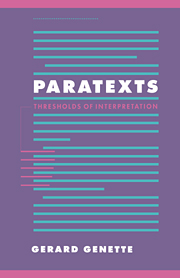Book contents
- Frontmatter
- Contents
- Foreword
- List of books by Gérard Genette
- Translator's note
- 1 Introduction
- 2 The publisher's peritext
- 3 The name of the author
- 4 Titles
- 5 The please-insert
- 6 Dedications and inscriptions
- 7 Epigraphs
- 8 The prefatorial situation of communication
- 9 The functions of the original preface
- 10 Other prefaces, other functions
- 11 Intertitles
- 12 Notes
- 13 The public epitext
- 14 The private epitext
- 15 Conclusion
- Additional references
- Index
7 - Epigraphs
Published online by Cambridge University Press: 04 November 2009
- Frontmatter
- Contents
- Foreword
- List of books by Gérard Genette
- Translator's note
- 1 Introduction
- 2 The publisher's peritext
- 3 The name of the author
- 4 Titles
- 5 The please-insert
- 6 Dedications and inscriptions
- 7 Epigraphs
- 8 The prefatorial situation of communication
- 9 The functions of the original preface
- 10 Other prefaces, other functions
- 11 Intertitles
- 12 Notes
- 13 The public epitext
- 14 The private epitext
- 15 Conclusion
- Additional references
- Index
Summary
Epigraphs
I will define the epigraph roughly as a quotation placed en exergue [in the exergue], generally at the head of a work or a section of a work; literally, en exergue means off the work, which is going a little too far. Here the exergue is, rather, at the edge of the work, generally closest to the text – thus, following the dedication, if there is one. Hence the metonymy, so common nowadays, of exergue for “epigraph” – a metonymy that does not seem to me very felicitous, for it confuses the thing with the place. But I will come back to this matter of location after the requisite informal historical survey. I will also come back to the term quotation, which calls for some specifications, or rather some broadening.
Historical survey
At first glance, the epigraph seems more recent than the dedication. I find no trace of it, at least as defined above, before the seventeenth century. But perhaps something older still, the author's coat of arms, must be seen as its forerunner. The text of the coat of arms – its motto – may indeed be a quotation, like the “Ab insidiis non est prudentia” from Pliny that Mateo Alemán incorporated into the title page of at least two of his works, Guzman de Alfarache and Ortografía castellana. What distinguishes the motto, therefore, is not necessarily its autographic characteristic but its independence in relation to the singular text – the fact that it can appear at the head of several works by the same author, who puts it, as it were, en exergue of his career, or of his entire life.
- Type
- Chapter
- Information
- ParatextsThresholds of Interpretation, pp. 144 - 160Publisher: Cambridge University PressPrint publication year: 1997
- 1
- Cited by



